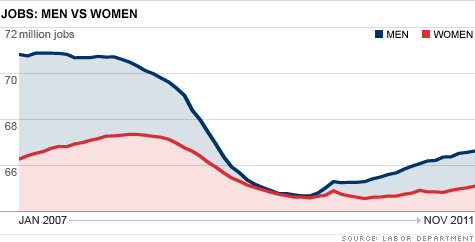Search News

NEW YORK (CNNMoney) -- In November, men got jobs. Women stopped looking.
The government's latest jobs report Friday showed a surprisingly large split between men and women. The unemployment rate fell for both groups, but for very different reasons.
The unemployment rate for adult men fell to 8.3% from 8.8%, with 474,000 additional men now saying they have jobs. The improved job market brought another 65,000 men back into the labor force.
Meanwhile, the unemployment rate for adult women also improved -- to 7.8% from 8.0%.
But that was because 438,000 women left the labor force during the month. The number of women with jobs fell by 214,000, but the unemployment rate declined because fewer women were looking for work.
Heidi Shierholz, a labor economist with the Economic Policy Institute, said the large gender discrepancy in the latest employment numbers is probably because the survey of households is more volatile than the separate survey of employers that also tracks jobs. The employer survey, which reported a gain of 120,000 jobs, found those jobs were split relatively evenly between men and women.
But Shierholz said historical readings in both surveys going back several years confirm the basic trend that men have made more gains in employment since the end of the Great Recession than women have. That's because men took a much bigger hit in employment during the period of sustained job losses.
"It isn't that men are doing awesome and women are getting screwed," she said. "But since we started adding jobs, most of the gains have gone to men."
Shierholz said the difference can be explained by the split in industries which are traditionally male dominated or female dominated. Construction, manufacturing and finance are typically fields where men are over-represented in the work force, and they were among the sectors hit hardest in the downturn.
Women are more prevalent in the education, health care and government sectors, which were more sheltered from job losses during the recession.
"If you look within each industry, women typically saw greater job losses. But men were more concentrated in industries that got hit hardest," she said.
Men lost so many more jobs than women that by late 2009 or early 2010, depending which survey you examine, the number of women and men working got close to parity for the first time since the government started tracking the gender of workers. But the difference has been growing larger on a pretty steady basis since then.
As for women leaving the work force in greater numbers, Shierholz said she's not sure what's behind that, other than the fact that traditionally in two-wage earner households, the lesser paid spouse is more likely to move in and out of the labor force than the primary wage earner. And in most cases, the husband is still the primary wage earner.
"Historically, women have been the reserve labor supply, they come in to the work force when times are good and leave when times are bad. But I don't know how true it is now," she said. ![]()
| Overnight Avg Rate | Latest | Change | Last Week |
|---|---|---|---|
| 30 yr fixed | 3.80% | 3.88% | |
| 15 yr fixed | 3.20% | 3.23% | |
| 5/1 ARM | 3.84% | 3.88% | |
| 30 yr refi | 3.82% | 3.93% | |
| 15 yr refi | 3.20% | 3.23% |
Today's featured rates:
| Latest Report | Next Update |
|---|---|
| Home prices | Aug 28 |
| Consumer confidence | Aug 28 |
| GDP | Aug 29 |
| Manufacturing (ISM) | Sept 4 |
| Jobs | Sept 7 |
| Inflation (CPI) | Sept 14 |
| Retail sales | Sept 14 |